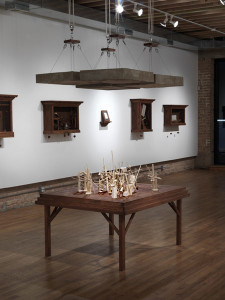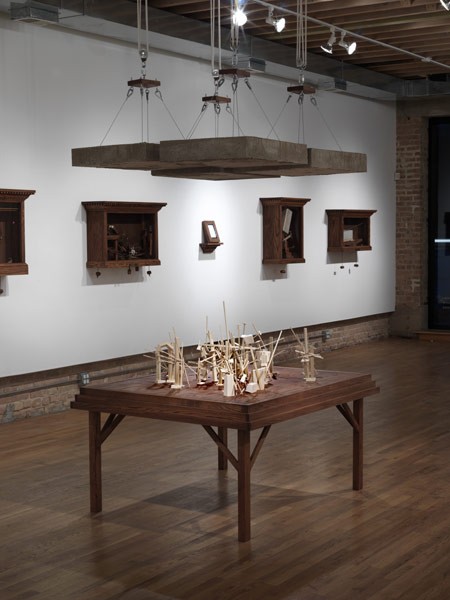Conrad Freiburg, “A Great Daydream”
September 5th – October 11th, 2008
Artist Reception: Friday, September 5th, 6-9 pm
Parlor Demonstration: Conversation Saturday, Oct. 4th, 2 pm
 Linda Warren Gallery is proud to kick-off the fall season with Conrad Freiburg’s second solo show at the gallery “A Great Daydream,” a timely exhibition, combining both interactive sculpture and installation that puts forth with true beauty and craftsmanship the artist’s formal and metaphorical interpretation of the Declaration of Independence.
Linda Warren Gallery is proud to kick-off the fall season with Conrad Freiburg’s second solo show at the gallery “A Great Daydream,” a timely exhibition, combining both interactive sculpture and installation that puts forth with true beauty and craftsmanship the artist’s formal and metaphorical interpretation of the Declaration of Independence.
As a thinker, Freiburg is akin to both scientist and engineer, producing work that displays an extraordinary understanding of math, physics and mechanics and purposefully amuses in its nearly absurd and contradictory handling of complexities with simplicities: sort of Rube Goldberg-like but also the antithesis. As an artist, this rational left-sided brain functionality becomes a servant to Freiburg’s ever-so powerful right and his visual poetry operates, albeit aesthetically, as a testing ground for engaging his own drive to understand human nature and determine if there are certain constants in our nature and, if so, what are they.
This question, or perhaps for Freiburg the algorithm, presents itself quite perfectly in the Declaration of Independence, created in a unique era by a group of special individuals in their quest to “appeal to the spirit of change through reason, their reason being, besides liberating themselves from the rule of Great Britain, the viewpoint; that there are certain truths to be self-evident, that all men are created equal, that they are endowed by their Creator with certain unalienable Rights, that among these are Life, Liberty and the pursuit of Happiness; That to secure these rights, Governments are instituted among Men, deriving their just powers from the consent of the governed;That whenever any Form of Government becomes destructive of these ends, it is the Right of the People to alter or to abolish it.”
All of the aforementioned notions, which Gore Vidal called “Jefferson’s great daydream,” rather “than any working political philosophy” (an origin for the title of this exhibition) is what Freiburg puts to the test, letting us choose to assent, dissent, or show indifference to his artistic interpretation of the above statement by giving us the ability to physically destroy it. In effect, he has created a type of “voting machine” whereby, depending upon the direction by which we decide to crank the lever provided, we are able to lower hundreds of pounds of concrete onto a mass of small sculptures (representing us, our individuality, and the lofty ideas/ideals of our founding forefathers) and destroy them and all of Freiburg’s months of work, not to mention, symbolically, our “Lilliputian republic.” Or not. Drawings of the miniature sculptures are also on display. The potential temporality of this main installation resonates for the artist as he has observed in past projects that the breaking of his art vastly increases the viewer’s interest of his artwork to become more aware and focused on its meaning.
One leads up to this crank after playing with Freiburg’s sculptural interpretations of thirteen phrases from the Declaration of Independence (thirteen the number simply to represent the thirteen colonies). These wall-mounted boxes, well-crafted using traditional carpentry inspired by the details of Jefferson’s Monticello and the aesthetics of the American tradition of backwoods experimentations are full of “whizbangery” and antiquated-looking gadgetry and design. Freiburg’s method of introducing quantitative substance to the “Framers Forms” are attempts to give meaning to the spirit of their thinking which, coincidentally, or not, does continue to resonate and activate our lives.
The project space will also exhibit an array of drawings produced by Freiburg over a period of a few years that reflect his many journeys and experiences.
Conrad Freiburg received his BFA in 2000 from the School of the ArtInstitute of Chicago. His first solo exhibition at the gallery in 2006, “The Slipping Glimpser” was received with tremendous enthusiasm and received wonderful reviews both locally and nationally, including the Chicago Tribune (for which he was also selected as a Chicagoan of the Year), Time Out, New City, NPR and Artnews. He has exhibited both nationally and internationally and has been the recipient of grants from the New York Foundation for the Arts, the Cliffdwellers Artist Residency program, and was most recently nominated for a Richard H. Dreihaus Foundation grant.
